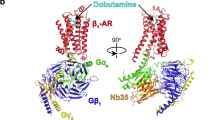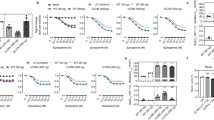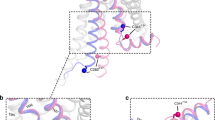Abstract
G protein–coupled receptors (GPCRs) mediate transmembrane signaling. Before ligand binding, GPCRs exist in a basal state. Crystal structures of several GPCRs bound with antagonists or agonists have been solved. However, the crystal structure of the ligand-free basal state of a GPCR, the starting point of GPCR activation and function, had not yet been determined. Here we report the X-ray crystal structure of the ligand-free basal state of a GPCR in a lipid membrane–like environment. Oligomeric turkey β1-adrenergic receptors display two dimer interfaces. One interface involves the transmembrane domain (TM) 1, TM2, the C-terminal H8 and extracellular loop 1. The other interface engages residues from TM4, TM5, intracellular loop 2 and extracellular loop 2. Structural comparisons show that this ligand-free state is in an inactive conformation. This provides the structural basis of GPCR dimerization and oligomerization.
This is a preview of subscription content, access via your institution
Access options
Subscribe to this journal
Receive 12 print issues and online access
$189.00 per year
only $15.75 per issue
Buy this article
- Purchase on Springer Link
- Instant access to full article PDF
Prices may be subject to local taxes which are calculated during checkout






Similar content being viewed by others
References
Pierce, K.L., Premont, R.T. & Lefkowitz, R.J. Seven-transmembrane receptors. Nat. Rev. Mol. Cell Biol. 3, 639–650 (2002).
Oldham, W.M. & Hamm, H.E. Heterotrimeric G protein activation by G-protein-coupled receptors. Nat. Rev. Mol. Cell Biol. 9, 60–71 (2008).
Vassart, G. & Costagliola, S. G protein-coupled receptors: mutations and endocrine diseases. Nat. Rev. Endocrinol. 7, 362–372 (2011).
Kenakin, T. & Miller, L.J. Seven transmembrane receptors as shapeshifting proteins: the impact of allosteric modulation and functional selectivity on new drug discovery. Pharmacol. Rev. 62, 265–304 (2010).
Lappano, R. & Maggiolini, M. G protein-coupled receptors: novel targets for drug discovery in cancer. Nat. Rev. Drug Discov. 10, 47–60 (2011).
Brunton, L. Goodman & Gilman's The Pharmacological Basis of Therapeutics 12th edn (McGraw-Hill Professional, 2010).
Palczewski, K. et al. Crystal structure of rhodopsin: a G protein-coupled receptor. Science 289, 739–745 (2000).
Cherezov, V. et al. High-resolution crystal structure of an engineered human β2-adrenergic G protein-coupled receptor. Science 318, 1258–1265 (2007).
Rasmussen, S.G. et al. Crystal structure of the human β2 adrenergic G-protein-coupled receptor. Nature 450, 383–387 (2007).
Warne, T. et al. Structure of a β1-adrenergic G-protein-coupled receptor. Nature 454, 486–491 (2008).
Jaakola, V.P. et al. The 2.6 Å crystal structure of a human A2A adenosine receptor bound to an antagonist. Science 322, 1211–1217 (2008).
Park, J.H., Scheerer, P., Hofmann, K.P., Choe, H.W. & Ernst, O.P. Crystal structure of the ligand-free G-protein-coupled receptor opsin. Nature 454, 183–187 (2008).
Scheerer, P. et al. Crystal structure of opsin in its G-protein-interacting conformation. Nature 455, 497–502 (2008).
Murakami, M. & Kouyama, T. Crystal structure of squid rhodopsin. Nature 453, 363–367 (2008).
Wu, B. et al. Structures of the CXCR4 chemokine GPCR with small-molecule and cyclic peptide antagonists. Science 330, 1066–1071 (2010).
Chien, E.Y. et al. Structure of the human dopamine D3 receptor in complex with a D2/D3 selective antagonist. Science 330, 1091–1095 (2010).
Rasmussen, S.G. et al. Structure of a nanobody-stabilized active state of the β(2) adrenoceptor. Nature 469, 175–180 (2011).
Warne, T. et al. The structural basis for agonist and partial agonist action on a β(1)-adrenergic receptor. Nature 469, 241–244 (2011).
Shimamura, T. et al. Structure of the human histamine H(1) receptor complex with doxepin. Nature 475, 65–70 (2011).
Xu, F. et al. Structure of an agonist-bound human A2A adenosine receptor. Science 332, 322–327 (2011).
Lebon, G. et al. Agonist-bound adenosine A(2A) receptor structures reveal common features of GPCR activation. Nature 474, 521–525 (2011).
Choe, H.W. et al. Crystal structure of metarhodopsin II. Nature 471, 651–655 (2011).
Standfuss, J. et al. The structural basis of agonist-induced activation in constitutively active rhodopsin. Nature 471, 656–660 (2011).
Rasmussen, S.G. et al. Crystal structure of the β2 adrenergic receptor-Gs protein complex. Nature 477, 549–555 (2011).
Sakmar, T.P. Structure of rhodopsin and the superfamily of seven-helical receptors: the same and not the same. Curr. Opin. Cell Biol. 14, 189–195 (2002).
Angers, S., Salahpour, A. & Bouvier, M. Dimerization: an emerging concept for G protein-coupled receptor ontogeny and function. Annu. Rev. Pharmacol. Toxicol. 42, 409–435 (2002).
Filizola, M. & Weinstein, H. The study of G-protein coupled receptor oligomerization with computational modeling and bioinformatics. FEBS J. 272, 2926–2938 (2005).
Milligan, G. The role of dimerisation in the cellular trafficking of G-protein-coupled receptors. Curr. Opin. Pharmacol. 10, 23–29 (2010).
Palczewski, K. Oligomeric forms of G protein-coupled receptors (GPCRs). Trends Biochem. Sci. 35, 595–600 (2010).
Klco, J.M., Lassere, T.B. & Baranski, T.J. C5a receptor oligomerization. I. Disulfide trapping reveals oligomers and potential contact surfaces in a G protein-coupled receptor. J. Biol. Chem. 278, 35345–35353 (2003).
Guo, W. et al. Dopamine D2 receptors form higher order oligomers at physiological expression levels. EMBO J. 27, 2293–2304 (2008).
Liang, Y. et al. Organization of the G protein-coupled receptors rhodopsin and opsin in native membranes. J. Biol. Chem. 278, 21655–21662 (2003).
Kota, P., Reeves, P.J., Rajbhandary, U.L. & Khorana, H.G. Opsin is present as dimers in COS1 cells: identification of amino acids at the dimeric interface. Proc. Natl. Acad. Sci. USA 103, 3054–3059 (2006).
Han, Y., Moreira, I.S., Urizar, E., Weinstein, H. & Javitch, J.A. Allosteric communication between protomers of dopamine class A GPCR dimers modulates activation. Nat. Chem. Biol. 5, 688–695 (2009).
Bouvier, M. Oligomerization of G-protein-coupled transmitter receptors. Nat. Rev. Neurosci. 2, 274–286 (2001).
Lohse, M.J. Dimerization in GPCR mobility and signaling. Curr. Opin. Pharmacol. 10, 53–58 (2010).
Mercier, J.F., Salahpour, A., Angers, S., Breit, A. & Bouvier, M. Quantitative assessment of β1- and β2-adrenergic receptor homo- and heterodimerization by bioluminescence resonance energy transfer. J. Biol. Chem. 277, 44925–44931 (2002).
Kobayashi, H., Ogawa, K., Yao, R., Lichtarge, O. & Bouvier, M. Functional rescue of β-adrenoceptor dimerization and trafficking by pharmacological chaperones. Traffic 10, 1019–1033 (2009).
Guo, W., Shi, L. & Javitch, J.A. The fourth transmembrane segment forms the interface of the dopamine D2 receptor homodimer. J. Biol. Chem. 278, 4385–4388 (2003).
Guo, W., Shi, L., Filizola, M., Weinstein, H. & Javitch, J.A. Crosstalk in G protein-coupled receptors: changes at the transmembrane homodimer interface determine activation. Proc. Natl. Acad. Sci. USA 102, 17495–17500 (2005).
Mancia, F., Assur, Z., Herman, A.G., Siegel, R. & Hendrickson, W.A. Ligand sensitivity in dimeric associations of the serotonin 5HT2c receptor. EMBO Rep. 9, 363–369 (2008).
Ballesteros, J.A. & Weinstein, H. Integrated methods for the construction of three-dimensional models and computational probing of structure-function relations in G protein-coupled receptors. Methods Neurosci. 25, 366–428 (1995).
Moukhametzianov, R. et al. Two distinct conformations of helix 6 observed in antagonist-bound structures of a β1-adrenergic receptor. Proc. Natl. Acad. Sci. USA 108, 8228–8232 (2011).
Baker, J.G., Proudman, R.G. & Tate, C.G. The pharmacological effects of the thermostabilising (m23) mutations and intra and extracellular (β36) deletions essential for crystallisation of the turkey β-adrenoceptor. Naunyn Schmiedebergs Arch. Pharmacol. 384, 71–91 (2011).
Salom, D. et al. Crystal structure of a photoactivated deprotonated intermediate of rhodopsin. Proc. Natl. Acad. Sci. USA 103, 16123–16128 (2006).
Wu, H. et al. Structure of the human κ-opioid receptor in complex with JDTic. Nature 485, 327–332 (2012).
Manglik, A. et al. Crystal structure of the μ-opioid receptor bound to a morphinan antagonist. Nature 485, 321–326 (2012).
Smith, N.J. & Milligan, G. Allostery at G protein-coupled receptor homo- and heteromers: uncharted pharmacological landscapes. Pharmacol. Rev. 62, 701–725 (2010).
Hebert, T.E. et al. A peptide derived from a β2-adrenergic receptor transmembrane domain inhibits both receptor dimerization and activation. J. Biol. Chem. 271, 16384–16392 (1996).
Fung, J.J. et al. Ligand-regulated oligomerization of β(2)-adrenoceptors in a model lipid bilayer. EMBO J. 28, 3315–3328 (2009).
Damian, M., Martin, A., Mesnier, D., Pin, J.P. & Baneres, J.L. Asymmetric conformational changes in a GPCR dimer controlled by G-proteins. EMBO J. 25, 5693–5702 (2006).
Parker, E.M. & Ross, E.M. Truncation of the extended carboxyl-terminal domain increases the expression and regulatory activity of the avian β-adrenergic receptor. J. Biol. Chem. 266, 9987–9996 (1991).
Kawate, T. & Gouaux, E. Fluorescence-detection size-exclusion chromatography for precrystallization screening of integral membrane proteins. Structure 14, 673–681 (2006).
Sun, Y. et al. Dosage-dependent switch from G protein-coupled to G protein-independent signaling by a GPCR. EMBO J. 26, 53–64 (2007).
Henis, Y.I., Hekman, M., Elson, E.L. & Helmreich, E.J. Lateral motion of β receptors in membranes of cultured liver cells. Proc. Natl. Acad. Sci. USA 79, 2907–2911 (1982).
Caron, M.G., Srinivasan, Y., Pitha, J., Kociolek, K. & Lefkowitz, R.J. Affinity chromatography of the β-adrenergic receptor. J. Biol. Chem. 254, 2923–2927 (1979).
Warne, T., Chirnside, J. & Schertler, G.F. Expression and purification of truncated, non-glycosylated turkey β-adrenergic receptors for crystallization. Biochim. Biophys. Acta 1610, 133–140 (2003).
Modest, V.E. & Butterworth, J.F. 4th. Effect of pH and lidocaine on β-adrenergic receptor binding. Interaction during resuscitation? Chest 108, 1373–1379 (1995).
Kabsch, W. Xds. Acta Crystallogr. D Biol. Crystallogr. 66, 125–132 (2010).
Strong, M. et al. Toward the structural genomics of complexes: crystal structure of a PE/PPE protein complex from Mycobacterium tuberculosis. Proc. Natl. Acad. Sci. USA 103, 8060–8065 (2006).
McCoy, A.J. et al. Phaser crystallographic software. J. Appl. Crystallogr. 40, 658–674 (2007).
Murshudov, G.N., Vagin, A.A. & Dodson, E.J. Refinement of macromolecular structures by the maximum-likelihood method. Acta Crystallogr. D Biol. Crystallogr. 53, 240–255 (1997).
Adams, P.D. et al. PHENIX: a comprehensive Python-based system for macromolecular structure solution. Acta Crystallogr. D Biol. Crystallogr. 66, 213–221 (2010).
Emsley, P. & Cowtan, K. Coot: model-building tools for molecular graphics. Acta Crystallogr. D Biol. Crystallogr. 60, 2126–2132 (2004).
Davis, I.W., Murray, L.W., Richardson, J.S. & Richardson, D.C. MOLPROBITY: structure validation and all-atom contact analysis for nucleic acids and their complexes. Nucleic Acids Res. 32, W615–W619 (2004).
Krissinel, E. & Henrick, K. Inference of macromolecular assemblies from crystalline state. J. Mol. Biol. 372, 774–797 (2007).
Acknowledgements
We thank O. Andersen, O. Boudker, J. McCoy, C. Steegborn, Y. Sun, G. Verdon and W. Xu for advice, discussions and help. We thank E. Ross (University of Texas Southwestern Medical Center, Dallas, Texas, USA) for the turkey β1-AR plasmid, E. Gouaux (Vollum Institute, Portland, Oregon, USA) and O. Boudker (Weill Cornell Medical College, New York, New York, USA) for the pCGFP-EU plasmid and Cornell's chemistry core facility for the synthesis of alprenolol-NH2. We thank I. Kourinov at the Advanced Photon Source beamline 24-ID-E and J. Jakoncic at the Brookhaven National Laboratory NSLS beamlines X6A and X25 for their assistance with X-ray data collection. We are grateful to O. Boudker, H. Weinstein and members of our laboratory for critically reading the manuscript. This work was supported by US National Institutes of Health grant HL 91525 (X.-Y.H.).
Author information
Authors and Affiliations
Contributions
J.H. performed the protein purification, set up crystallization trials, grew crystals for data collection and participated in data collection. S.C. processed the diffraction data, and solved and refined the structures. J.J.Z. participated in project strategy and manuscript preparation. X.-Y.H. was responsible for the overall project strategy and management and participated in data collection and wrote the manuscript.
Corresponding author
Ethics declarations
Competing interests
The authors declare no competing financial interests.
Supplementary information
Supplementary Text and Figures
Supplementary Figures 1–7 and Supplementary Note (PDF 10528 kb)
Rights and permissions
About this article
Cite this article
Huang, J., Chen, S., Zhang, J. et al. Crystal structure of oligomeric β1-adrenergic G protein–coupled receptors in ligand-free basal state. Nat Struct Mol Biol 20, 419–425 (2013). https://doi.org/10.1038/nsmb.2504
Received:
Accepted:
Published:
Issue Date:
DOI: https://doi.org/10.1038/nsmb.2504
This article is cited by
-
Structural insight into apelin receptor-G protein stoichiometry
Nature Structural & Molecular Biology (2022)
-
Structural basis and mechanism of activation of two different families of G proteins by the same GPCR
Nature Structural & Molecular Biology (2021)
-
Structure and function of adenosine receptor heteromers
Cellular and Molecular Life Sciences (2021)
-
Combinatorial allosteric modulation of agonist response in a self-interacting G-protein coupled receptor
Communications Biology (2020)
-
A benchmark study of loop modeling methods applied to G protein-coupled receptors
Journal of Computer-Aided Molecular Design (2019)



